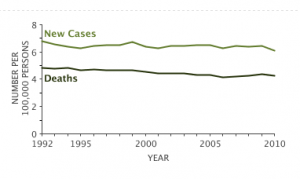WiFi context
Age-adjusted brain cancer diagnoses and deaths in the US over time (SEER)
The IEEE 802.11a standard was published in 1999 and was first called WiFi in 2000. WiFi exposure has increased dramatically since then. You can see what the trend in brain cancer has been.
The International Agency for Cancer Research (IARC) lists WiFi as a ‘possible’ human carcinogen. That doesn’t mean they think it’s actually causing cancer. That means there’s enough uncertainty that they can’t rule out the possibility that it would cause cancer at some dose.
A cancer ‘hazard’ is an agent that is capable of causing cancer under some circumstances, while a cancer ‘risk’ is an estimate of the carcinogenic effects expected from exposure to a cancer hazard. The Monographs are an exercise in evaluating cancer hazards, despite the historical presence of the word ‘risks’ in the title. The distinction between hazard and risk is important, and the Monographs identify cancer hazards even when risks are very low at current exposure levels, because new uses or unforeseen exposures could engender risks that are significantly higher.
It’s quite hard to rule this sort of thing out, which is why out of the 970 agents IARC has classified, only one has been labelled “probably not carcinogenic to humans”. That one wasn’t radiofrequency electromagnetic fields, but if you read the summary of the monograph (PDF) you find it’s cellphones held to the ear that are the possible risk they were concerned about.
This information may be helpful context if you read the Dominion Post.
Thomas Lumley (@tslumley) is Professor of Biostatistics at the University of Auckland. His research interests include semiparametric models, survey sampling, statistical computing, foundations of statistics, and whatever methodological problems his medical collaborators come up with. He also blogs at Biased and Inefficient See all posts by Thomas Lumley »

UK statistics at http://www.cancerresearchuk.org/cancer-info/cancerstats/types/brain/incidence/uk-brain-and-central-nervous-system-cancer-incidence-statistics#Trends suggest that while has been an upward trend in the higher age groups, there has been none for younger people (0-49, see Fig. 1.5), which is where the concern has been expressed in relation to schools, etc.
10 years ago
Yes. The people who do the US statistics think that is mostly improvements in diagnosis in the elderly, both that imaging techniques allow smaller tumours to be diagnosed, and that there is less willingness to write off neurological deficits as normal.
10 years ago